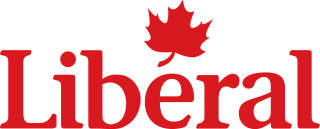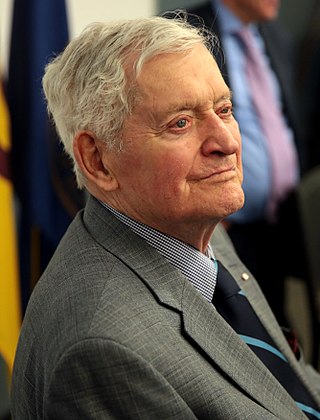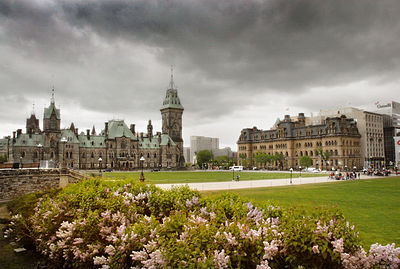
The prime minister of Canada is the head of government of Canada. Not outlined in any constitutional document, the office exists only per long-established convention. Under the Westminster system, the prime minister governs with the confidence of a majority of the elected House of Commons; as such, the prime minister typically sits as a member of Parliament (MP) and leads the largest party or a coalition of parties. The prime minister is appointed by the monarch's representative, the governor general, and, as first minister, selects other ministers to form the Cabinet and chairs it. Constitutionally, executive authority is vested in the monarch, but, in practice, the powers of the monarch and governor general are nearly always exercised on the advice of the Cabinet, which is collectively responsible to the House of Commons. Canadian prime ministers are appointed to the Privy Council and styled as the Right Honourable, a privilege maintained for life.

John Napier Wyndham Turner was a Canadian lawyer and politician who served as the 17th prime minister of Canada from June to September 1984. He served as leader of the Liberal Party of Canada and leader of the Official Opposition from 1984 to 1990.

Martin Brian Mulroney was a Canadian lawyer, businessman, and politician who served as the 18th prime minister of Canada from 1984 to 1993.

Charles Joseph Clark is a Canadian businessman, writer, and politician who served as the 16th prime minister of Canada from 1979 to 1980.

The Progressive Conservative Party of Canada was a centre to centre-right federal political party in Canada that existed from 1942 to 2003.

The Liberal Party of Canada is a federal political party in Canada. The party espouses the principles of liberalism, and generally sits at the centre to centre-left of the Canadian political spectrum, with their main rival, the Conservative Party, positioned to their right and the New Democratic Party positioned to their left. The party is described as "big tent", practising "brokerage politics", attracting support from a broad spectrum of voters. The Liberal Party is the longest-serving and oldest active federal political party in the country, and has dominated federal politics of Canada for much of its history, holding power for almost 70 years of the 20th century. As a result, it has sometimes been referred to as Canada's "natural governing party".

24 Sussex Drive, originally called Gorffwysfa and usually referred to simply as 24 Sussex, is the official residence of the prime minister of Canada, located in the New Edinburgh neighbourhood of Ottawa, Ontario. Built between 1866 and 1868 by Joseph Merrill Currier, it has been the official home of the prime minister of Canada since 1951. It is one of two official residences made available to the prime minister, the Harrington Lake estate in nearby Gatineau Park being the other.

The spouse of the prime minister of Canada is the wife or husband of the prime minister of Canada. Sophie Grégoire Trudeau is married to the 23rd and current prime minister, Justin Trudeau, though the couple have been separated since August 2, 2023.
Donald Frank Mazankowski was a Canadian politician who served as a cabinet minister under prime ministers Joe Clark and Brian Mulroney, including as deputy prime minister under Mulroney.

During the history of Canadian politics, thirteen minority governments have been elected at the federal level. There have also been two minority governments resulting from governments being replaced between elections, for a total of fifteen federal minority governments in thirteen separate minority parliaments. There have been historical cases where the governing party had fewer than half of the seats but had the support of independents who called themselves members of the party; these cases are not included, as there was never any serious chance of the government falling.

The history of Canada (1982–present) refers to the period immediately following the Canada Act until the present.

Avril Phaedra Douglas "Kim" Campbell is a former Canadian politician, diplomat, lawyer, and writer who served as the 19th prime minister of Canada from June 25 to November 4, 1993. Campbell is the first and only female prime minister of Canada. Prior to becoming the final Progressive Conservative (PC) prime minister, she was also the first woman to serve as minister of justice in Canadian history and the first woman to become minister of defence in a NATO member state.

Lester Bowles "Mike" Pearson was a Canadian politician, diplomat, statesman, and scholar who served as the 14th Prime Minister of Canada from 1963 to 1968.
There have been numerous depictions of prime ministers of Canada in popular culture.

This article is the electoral history of Louis St. Laurent, the twelfth prime minister of Canada (1948–1957).

This article is the Electoral history of John Turner, the seventeenth Prime Minister of Canada.

This article is the Electoral history of Brian Mulroney, the eighteenth Prime Minister of Canada.

The heraldic mark of the prime minister of Canada is granted exclusively to holders of the office who pursue an official personal coat of arms from the Canadian Heraldic Authority.















